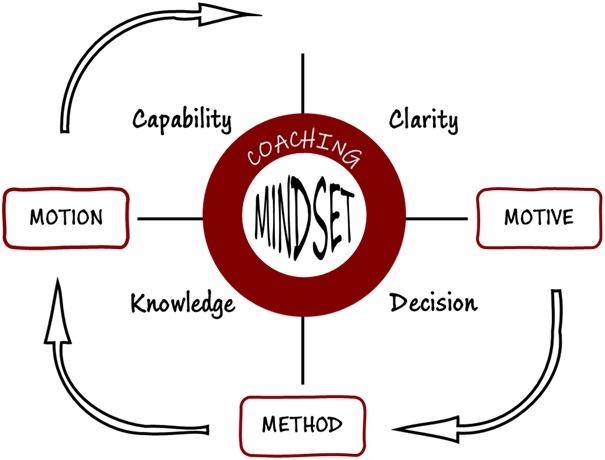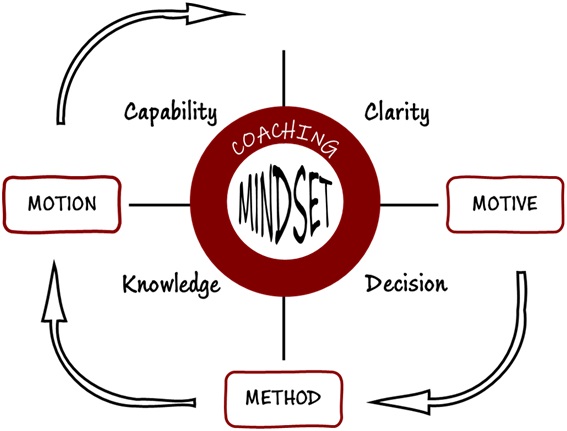A Coaching Model Created by Audrey Blair
(Leadership & Confidence Coach, UNITED STATES)


Everybody ends up somewhere …
Only a few ends up there on purpose
It Only Takes a Little Bit of Faith to Move a Mountain
Move Your Mountain framework

Change is the act of becoming different, a transformation. It’s everywhere. We see it in nature, as seasons flow from one to the next, we see it in our workplaces through digital policies and technology, we see it in ourselves. We may be asked by an outside influence, or it could be self-imposed; no matter the origin, change is hard. Positive or negative, it doesn’t matter. To change, there must be a loss. Our minds are designed to be efficient and work to create habits out of our behavioral and thought patterns. Breaking those patterns is where the disruption lies.
It’s been said that with a little bit of faith (hope, belief), the impossible can happen.
If you have faith the size of a mustard seed, you will tell this mountain, ‘Move from here to there,’ and it will move. Nothing will be impossible for you. – Matt 17:20
Many think of the mountain as the obstacle in the way or the goal that needs to be reached. But I challenge this thinking; those things aren’t moveable, they are reachable, so for something to occur, it is you that must move, you are the mountain. If you say to yourself, ‘Move from here to there,’ you can control that. All it takes is a little bit of faith to take the first step, gain momentum, and keep going.
Coaching someone through a transformation requires helping them break down the mental barriers that prevent those first significant steps. The Move Your Mountain framework has three layers that build on each other: Barriers to Building Blocks, 3M Coaching Model, and Mindset.
Barriers to Building Blocks
When there is a change at hand and a feeling of being stuck, there are fundamental barriers that need to address to move forward. When we don’t know what they are or how they are blocking progress, they are truly barriers. However, once they have been identified, they can be converted to building blocks, the foundation of the change.
Barrier 1: CLARITY
Change begins with understanding the “what” and the ‘why’. There must be clarity around the change itself, the motivators, and the impact. Many people don’t realize what needs to change. “I want a new job”, or “I need to lose weight”, are no changes, they are results. Having an awareness of the particular barrier(s) that are preventing the desired result is paramount. It is necessary to work on identifying the action, mindset, belief, relationship, location, behavior, or habit that is at the center. Otherwise, at worst, the desired result won’t be reached, at best, it will be short-lived.
Another key element to clarity is how much of the change is driven by extrinsic vs. intrinsic factors. We can experience the pressure of someone else’s expectations of us, take on the burden of trying to meet those expectations, and still not be fulfilled in the process. A classic example is an adult holding on to the career expectations of the parent, even when it’s something they don’t have an interest in. The struggle to become or change for someone else makes the uphill challenge steeper.
Barrier 2: DECISION
The decision represents the motivation and ultimate choice to believe and act on the change. This must come from within as a voluntary choice one has to make. Without a decision, there is no commitment. Let’s face it, change is hard; on any given initiative, 84% of people resist change. On top of that, many experience change fatigue. So what gives? Well, many times we go through the motions without processing why we do what we do (see barrier #1). It’s not that we are mindless zombies our minds are designed to run as efficiently as possible! So, when there is an opportunity to create a habit out of repeated thoughts and behaviors, our mind creates one. To make a change, we must decide to disrupt that automatic process and actively create a new one.
Barrier 3: KNOWLEDGE
Sometimes we know what to do but don’t know-how. Knowledge represents “the how” of implementing the change. Working through this phase will expose any gaps that may prevent forward momentum. Here, it is necessary to get beyond the “what” and get tactical. It’s easy to hold on to a vision, get excited, get motivated, and want to skip to the result. The challenge with moving too fast without a plan is like picking out a place on a map that you’d like to go, without first knowing where you are, figuring out how to get there, or estimating the travel time. When obstacles arise, it’s easier to pivot when there is a plan.
Barrier 4: CAPABILITY
This stage represents the ability to execute the plan and take action. Knowledge is not enough … I know what it takes to participate in a triathlon, but I can’t do it today. It takes time to get in shape and become proficient. People can get discouraged when a change takes longer to implement, or the skills required take longer to master. This stage not only takes patience, but it also requires an expectation to keep moving forward.
3M Coaching Model: MOTIVE | METHOD | MOTION
Coaching helps clients to identify the barriers and reframe them as building blocks for each stage of the model.
MOTIV
The motive is all about finding the why and envisioning the possible. The barriers that need to be reframed as building blocks: Clarity and Decision
Coaching Questions:
METHO
The method is about taking the vision and creating a plan of execution; getting specific about how to reach the goal. The barrier that needs to be reframed as a building block: Knowledge
Coaching Questions:
MOTI
To get from here to there, you must move … remember, “You are the Mountain”. The barrier that needs to be reframed as a building block: Capability
Coaching Questions:
Mindset
Mindset is everything; what we think, we become. A primary benefit of working with a coach is the powerful effect of a mind shift. Many people wait for others to permit them to transform, to be happy, to achieve, but ultimately, we are the principal gatekeeper. Success and achieving goals are not a precursor to happiness; happiness is a precursor to success and achieving goals. Learning and trusting the process brings the greatest reward when we let it. The gift of coaching helps to stay on track.
